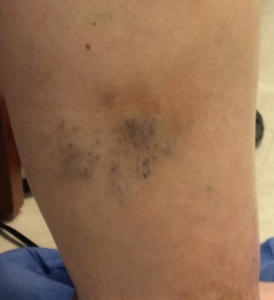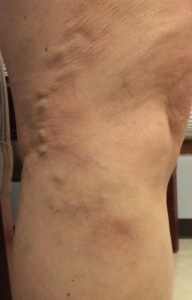Varicose Veins Pain: Leg Cosmetic Issue or Medical Condition?
Do you have tired, throbbing, painful legs? Are you concerned about varicose veins pain? Perhaps you have been told that varicose veins are only a cosmetic problem. Or, possibly you have family or friends who have undergone surgery only to be disappointed with the results. Procedures are different now. There are many options available for treating the nagging leg vein pain.
The varicose veins in this patient caused considerable pain especially when she she was active enjoying hiking and an active lifestyle.
What does varicose vein pain feel like?
Usually varicose veins pain is described as:
- Throbbing, cramping, aching or burning pain.
- The pain may be associated with leg swelling, itching, heaviness and skin discoloration.
- Often the leg vein pain is worse at the end of the day and better in the morning.
- Also, the veins in leg hurt worse when they are enlarged. The leg veins become more prominent and swell with prolonged standing or sitting, heat, and exercise
Can a spider vein cause pain?

Yes, spider veins can be painful. Typically, spider veins have no symptoms. However, as the spider veins enlarge they can itch, pinch, burn, tingle or cause a pressure-like discomfort. Eventually they can throb and ache or even bleed.
What causes varicose leg vein pain?
Varicose veins are caused by a failure of the valves in the leg veins. This leads to a backup of blood in the veins with the veins becoming larger and rope-like. This enlargement of the veins can cause inflammation which leads to pain. Occasionally, clots can form in the varicose veins which can also be quite painful. The picture below shows redness along the varicose veins as seen with superficial phlebitis.

What can I do to alleviate leg vein pain?
- Get moving – avoid long periods of standing or sitting. We have both arteries and veins in our legs. The arteries beat all the time and carry the blood to our feet. That blood goes through a filter bed so the tissues get the oxygen and nutrients. The veins carry the blood back to our heart. But remember, there is no big pump at our feet. The blood flow moves in the veins when we exercise the calf muscle. The muscle squeeze compresses the vein and forces the blood flow forward. We were built to move, not sit in chairs. If sitting or standing, do foot movements (heel-toe, spell alphabet with feet, etc)
- Elevate – Get your legs above heart level.
- Lose Weight – Those extra pounds puts added pressure on the veins in your legs
- Wear Compression socks/stocking but avoid tight clothes – Medical grade graduated compression stocking are tightest at the ankle and have lesser compression as they go up the leg. This forces the venous blood flow into the deep veins and up the leg. Tight compression sleeves and leggings do not work in this way and they can cause more foot and ankle swelling increasing pain.
- Cool– use cool water or ice on your legs
Are there natural remedies for my varicose vein pain?
The most widely studied natural supplement for varicose veins is horse chestnut. Horse Chestnut contains the active ingredient Aescin which has been shown in clinical trials to reduce pain and swelling. However, there are some drawbacks to Horse Chestnut. It is only approved for short term use. As with all drug/supplements consult your physician before using.
What if the vein in my legs still hurt?
Many office based procedures are available to treat varicose veins. Insurance usually will cover these procedures when varicose veins cause symptoms. Most procedures are done in an hour and you are walking immediately afterwards. There is very little down time or discomfort with the newer available procedures. We are happy to answer any questions you may have at Lakeshore Veins, a Mequon, Wisconsin vein clinic.




